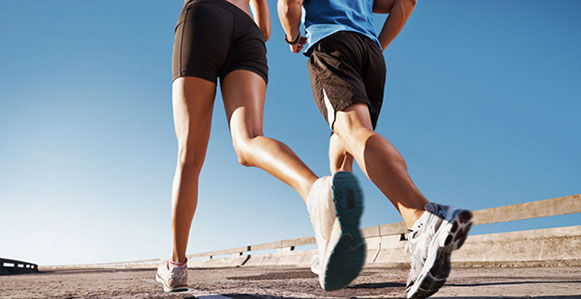
Great-looking legs are a sign of youth, vitality, fitness and general well being. Dancers, athletes and people engaged in dynamic pursuits that require the body to move in multiple planes of movement typically have toned and/or well-developed legs that are admired by others. Many fitness clients express a desire for shapely legs, so we must design exercise programs that will bring about that result. In the pursuit of awesome legs, however, we sometimes utilize exercises that inadvertently set a person up to experience knee pain. This article explains the anatomy behind great-looking legs, what exercises to avoid to help keep knees pain-free, and ideal exercises to incorporate into fitness programs to create the perfect pins.
Anatomy of “Great Legs”
To help you appreciate why dancers, athletes and others that engage in dynamic weight-bearing activities have great-looking legs, you need to understand the real-life function of the major muscles of the lower body. While the traditional view of anatomy gives us some insight into the origins, insertions and actions of muscles, it does little to help us understand how our legs work when the power of nature (i.e., gravity and ground reaction forces) is present.
When it comes to the major muscles of the leg, for example, we are typically taught that the quadriceps muscles are responsible for extending (i.e., straightening) the knee and that the adductors help bring the leg across the body. We are also taught that the hamstrings help flex the knee, the glutes rotate the leg out and push the hips forward, and that the calf muscles plantarflex and/or dorsiflex the foot and ankle (i.e., push the foot down or help lift it up) (Golding and Golding, 2003). This traditional anatomical information does not take into account the function of these muscles when a person is actively using his or her legs in a dynamic and weight-bearing fashion. Knowing what happens to these muscles as they are actively being used will enable you to design exercise programs that provide the desired aesthetic rewards for your clients while minimizing risk of injury.
The Bungee Cord System of Muscles
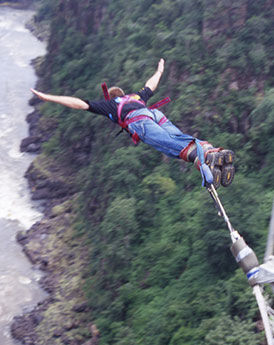
The easiest way to explain how muscles work in real life is to liken them to bungee cords, such as the kind used in bungee jumping. Bungee cords lengthen under load to help mitigate the potentially destructive effects of gravity by pulling taut at the right moment to stop the jumper from crashing forcefully into the ground. When the cord reaches its optimal tension, the potential energy stored in it is released, resulting in powerful movements (Price and Bratcher, 2010).
Weight-bearing endeavors on both feet, such as dancing or sport, also involve the downward pull of gravity on the body. They also involve the upward impact the body experiences as the opposite reaction to gravity (i.e., ground reaction forces). As such, the leg muscles lengthen under tension like bungee cords to decelerate forces to the joints and protect the body from injury (Price and Bratcher, 2010). This repeated lengthening of the muscles enables us to resist gravity and effectively transfer ground reaction forces, which ultimately strengthens muscles and builds great-looking legs.
Muscles of the Lower Leg
There are many muscles in the lower leg (e.g., the soleus, gastrocnemius, tibialis anterior, tibialis posterior and peroneals) that help slow down forces to the feet, ankles and knees as we move. The soleus and gastrocnemius, which merge into the Achilles tendon and attach to the heel bone (Gray, 1995), are two muscles in particular that contribute to nice looking legs. Here’s how they function in real-life movements. As gravity pulls our knee down and forward during motions such as squatting and lunging, the soleus lengthens like a bungee cord to help slow down the ankle and knee as they bend (Figure 1). When the knee straightens (as the leg travels behind you when walking, etc.), the gastrocnemius muscle lengthens to slow down the knee as it extends. (Note: The hip flexors also work like a bungee cord to slow down the knee as it straightens and the hip extends. As such, the gastrocnemius and hip flexors share a similar role in protecting the knee.)

Figure 1: Bungee Cord Action of the Soleus, Quadriceps, Gastrocnemius and Hip Flexors
Muscles of the Upper Leg
Quadriceps
When the knee bends during movements such as squatting, walking downstairs or lunging forward, the quadriceps muscles lengthen like bungee cords to help slow down forces to the knee joint (see Figure 1). All the quadriceps muscles attach to the kneecap, so when these muscles get tension in them from lengthening, they secure and stabilize the knee joint (Draves, 1986). Because the ankle and hip bend together during most weight-bearing activities, the quadriceps also play a secondary role in slowing down forces to the ankles and hips.
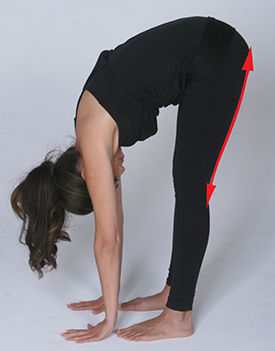
Figure 2: Bungee Cord Action of the Hamstrings
Hamstrings
The hamstrings originate on the “sit bones” (on the base of your pelvis) and attach to the lower leg behind the knee. When you bend forward at the waist, your “sit bones” move upward and away from the knee, which causes the hamstrings to lengthen like a bungee cord. This lengthening of the hamstrings minimizes stress to the joints of your pelvis and lower back as you bend forward (Dimon and Day, 2001) and also help slow down forces to your knee as it straightens (Figure 2).
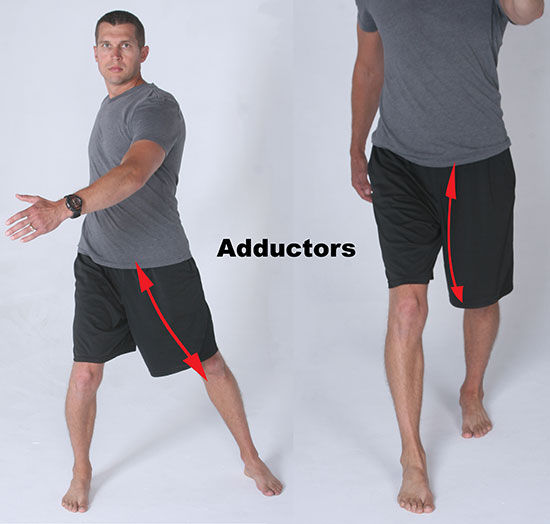
Figure 3: Bungee Cord Action of the Adductors
Adductors
The adductors (inner thigh muscles), which originate on the pelvis and attach to the inside of the leg, work like bungee cords in different planes of motion. When you transfer your weight from side to side (such as when playing basketball or ice skating), the adductors lengthen to slow down the pelvis as it moves away from the leg. When the leg travels behind the body (such as when walking or running), the adductors lengthen to slow down internal rotation of the leg (Leighton, 2006) (Figure 3).
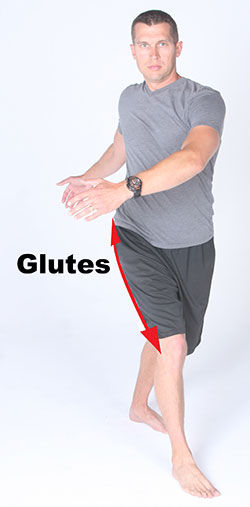
Figure 4: Bungee Cord Action of the Glutes
Glutes
There are several muscles that make up the gluteal complex (i.e., gluteus maximus, gluteus maximus and gluteus medius). These muscles all originate on the back of the pelvis and attach to the upper leg. They work in a lengthening fashion to help decelerate movement of the leg and pelvis as a person moves forward, side-to-side and over the foot during all weight-bearing activities (Figure 4). The glutes also help mitigate stress to the pelvis and spine. While the glutes are not exactly leg muscles, they do they play a key role in helping the legs move correctly during all lower-body movements, thereby protecting the knees from pain and injury (Price and Bratcher, 2010).
The real-life function of the major muscles of the lower body is what helps people develop great-looking legs. Hence, the exercises we design to build well-proportioned, strong and shapely legs should involve multiple, multiplanar movements for the feet, ankles, legs, hips, pelvis and spine.
Where We Typically Go Wrong with Leg Exercises
Gym and home-based exercise equipment provides people with a seemingly safe way to perform exercises for their leg workout routines. However, many of these pieces of equipment restrict full-body motion, which over time can lead to an overload of a certain body part (like the knees) and inflammation, pain and/or injury can result. This type of equipment also limits the necessity for exercisers to be truly weight-bearing when performing leg exercises. Following are a few examples of common leg exercises that may actually increase the likelihood of knee pain and/or injury because they do not train the muscles of the legs in a functional, weight-bearing fashion.
Calf Raises
Both seated and standing calf raises concentrate solely on moving the ankle to train the gastrocnemius and soleus muscle, and in a way that focuses on the concentric contraction. However, as was described earlier, the real-life function of the gastrocnemius is to lengthen to slow down forces to the ankle as it bends and to the knee as it straightens, while the soleus lengthens to help slow down forces to both the ankle and knee as these joints bend. Furthermore, while there is some rolling in and out of the ankle when performing calf raises, full range of motion in the lower leg is restricted. This means the engagement of other important muscles in this area (e.g., tibialis anterior, tibialis posterior and peroneals) is limited.
Leg Extensions
Seated leg extensions focus solely on straightening the knee to train the quadriceps when a person is not in a weight-bearing position. To prevent stress to the knees, hips and ankles, the quadriceps must be able to lengthen effectively during weight-bearing activities.
Leg Curls
Lying, seated or standing leg curls focus on bending the knee to train the hamstrings while the hips remain stationary. However, the real-life function of the hamstrings is to help slow down the knee as it straightens and the hip and spine as it bends forward when the feet are in contact with the ground. If the hamstrings are not flexible and able to lengthen effectively, they cannot perform this function effectively.
Adductor/Abductor Machine
The adductor and abductor machine focuses on training the inner and outer thigh by moving the leg from side to side in the hip socket. However, the real-life function of the adductor muscles is to also help slow down internal rotation of the leg and flexion and extension of the leg and hip. This type of exercise machine limits range of motion and excludes an important function of the adductors entirely.
Squats and Lunges
Squats and lunges are good exercises for training the majority of muscles in the legs. However, because the real-life function of the glutes is to decelerate forward and side-to-side movements of the leg, these muscles must be trained to work effectively in these planes of motion to minimize stress to the knee. Lunges restricted to the sagittal plane, barbell squats and exercises utilizing Smith machines can overload the knees and ankles in one plane of motion and cause both back and knee injuries.
The “Great Looking Legs” Program
Designing exercises that develop the muscles of the legs in a functional manner can improve the aesthetic and athletic capabilities of the lower body while minimizing unnecessary stress to the knees. Good mobility of the feet, ankles, knees, hips and pelvis are also necessary to train the legs effectively. Before having your clients attempt the exercises detailed below, it is recommended that you perform some quick assessments to make sure these exercises have the desired effect of taxing the muscles and not stressing the joints. This article from the January 2014 issue of ACE ProSource offers a great guide for assessing the structures of the lower body before getting started with this new leg routine.
Self-myofascial Release Warm-up (for all leg muscles, as appropriate)
Utilize appropriate self-myofascial release techniques and tools (e.g., foam rollers and tennis balls) to loosen up tissues that may be preventing correct movement of a particular body part. For example, if a client’s foot and ankle lack mobility, instruct them to perform some self-myofascial release techniques for the muscles on the underside of the foot and on the back and sides of the lower leg to help loosen up these structures before he or she works out. [An added benefit of performing self-myofascial release is that it has been found to help rebuild the subcutaneous tissues of the skin, which can minimize the appearance of cellulite (Silver, Siperko and Seehra, 2003).]
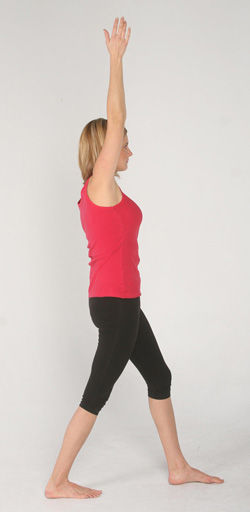
Step Back With Arm Raise (for gastrocnemius, tibialis anterior and posterior)
The gastrocnemius slows down dorsiflexion of the ankle and extension of the knee. The tibialis anterior and posterior help hold up the big arch of the foot as weight is transferred into it. Training these muscles, therefore, should involve movements that require the body to decelerate weight as it is transferred on to the foot and ankle as it bends and the knee as it straightens.
Coach your client to step back with the right foot and raise the right arm while keeping the back foot pointed forward. Repeat this exercise eight to 10 times on each side to warm up. When warmed up, progress to holding a light weight. Perform two to three sets of eight to 10 repititions on each side, two to three times per week. To progress this exercise further, coach your client to step backward off a small step while raising the arm or walk backward down a hill while alternately raising the arms.
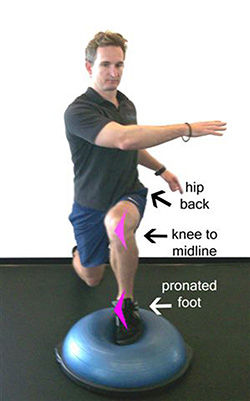
Multiplanar Lunges and Squats (for quads, soleus and glutes)
When the soleus and quadriceps are working well together, the hip is able to bend effectively as the leg travels over the foot. This coordinated motion engages the gluteal complex of muscles. To engage the glutes even more and help decelerate stress to the knee, have your client perform multiplanar squats and lunges. These types of leg exercises can minimize stress to the knee joint while maximizing tension to the muscles.
Have your client place one foot on an unstable surface (e.g., BOSU) and drop down into a forward lunge position. As the client bends into the lunge position, rotate the opposite arm and torso over the front knee to activate the gluteal muscles and help prevent stress to the knee. Perform on both legs for two to three sets of eight to 10 repetitions, two to three times per week.
The following exercise is a great frontal plane lunge variation that helps engage the gluteus medius and minimus to decelerate stress to the knee. Have your client lunge forward gently with the left foot while reaching the right arm out toward the right side. Make sure both feet are facing forward. As the client reaches to the right, instruct him or her to push the left hip to the left (i.e., away from the right hand) to help keep the body balanced over its center. Move the left leg/knee toward the midline of the body. Return to the starting position and repeat. Perform two to three sets of 10 to 15 repetitions, two to three times per week.
The following squat exercise involves stepping to the side, rotating and squatting simultaneously. The mutiplanar motion of this exercises strengthens the peroneal muscles that help hold up the lateral arch of the foot, as well as the soleus, quadriceps, and the entire glute complex.
Have your client stand with the feet hip-width apart and facing forward. Instruct the client to step toward the left side and lower body into a squat position. As the client does this, rotate the arms and torso over the left side of the body, ensuring that the torso remains upright. Return to the starting postion and repeat on the right side. Perform two to three sets of 8 to 10 repetitions on each side (16 to 20 total) while rotating to the right and left, two to three times per week.
Straight Leg Bends (for hamstrings)
The hamstring muscles lengthen to slow down knee extension and hip flexion. To train the hamstring muscles functionally, have your clients perform a series of forward bends while the legs and spine are straight.
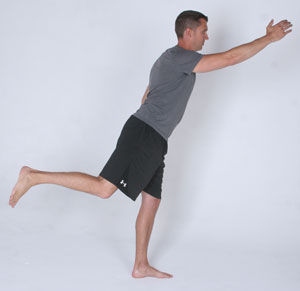 Stand with feet hip-width apart, feet facing forward and legs straight. Extend the arms in front of the body and bend forward at the waist as far as possible without bending your knees. To minimize stress to the lower back, keep the spine straight when flexing forward. Perform two to three sets of eight to 10 repetitions, two to three times per week. Once your client is proficient at this exercise, it can be progressed by having the client stand on one leg with the arm of the opposite side raised forward (as shown in the picture). To progress even further, a small hand weight can be added to the forward arm and the range of motion can be increased with the goal of getting the trunk perpendicular to the ground.
Stand with feet hip-width apart, feet facing forward and legs straight. Extend the arms in front of the body and bend forward at the waist as far as possible without bending your knees. To minimize stress to the lower back, keep the spine straight when flexing forward. Perform two to three sets of eight to 10 repetitions, two to three times per week. Once your client is proficient at this exercise, it can be progressed by having the client stand on one leg with the arm of the opposite side raised forward (as shown in the picture). To progress even further, a small hand weight can be added to the forward arm and the range of motion can be increased with the goal of getting the trunk perpendicular to the ground.
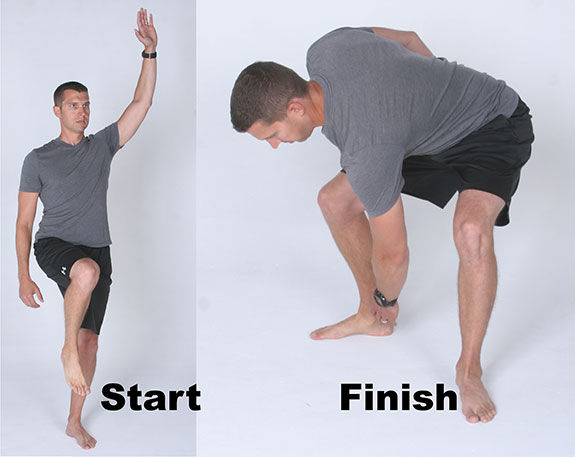
Sumo Squats (for adductors)
One of the major jobs of the adductor muscles is to decelerate the transfer of weight sideways from one leg to another. Having one leg off the ground to begin the following exercise places additional load on the adductors of the opposite leg as it has to decelerate the falling weight of the body as the other leg makes contact with the ground.
Have your client begin by standing on the left leg with the left arm raised overhead. While keeping the back straight, pivot around the left foot and squat while placing the right leg on the ground behind. Simultaneously reach your left hand toward your right foot. Return to the starting position and repeat. Perform two to three sets of eight to 10 repetitions on both sides, two to three times per week.
The exercises highlighted above are just a few of the techniques you can use to train the muscles of the legs for maximum athletic and aesthetic benefit. Applying your knowledge of the real life function of muscles will enable you to design limitless exercises that increase mobility, improve function, decrease knee pain and build great-looking legs.
Become a BioMechanics Method® Corrective Exercise Specialist
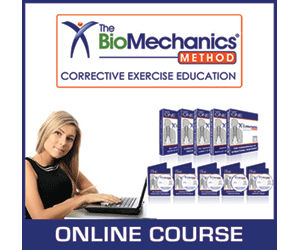
Want to learn more about how you can help your clients exercise with less pain? The BioMechanics Method® Corrective Exercise Specialist online course (TBMM-CES) is specifically designed to give fitness professionals a step-by-step process for helping clients overcome muscle and joint pain. Created by Justin Price, one of the top musculoskeletal assessment and corrective exercise experts in the world, this course will give you the postural assessment, anatomy, corrective exercise and program design skills necessary to help clients become pain free. This self-paced study course is valued at 8.0 ACE CECs and includes digital textbooks, videos and online quizzes.
References
Dimon, T. and Day M. (2001). Anatomy of the Moving Body: A Basic Course in Bones, Muscles, and Joints. Berkeley, Calif.: North Atlantic Books.
Draves, D. (1986). Anatomy of the Lower Extremity. Baltimore, Md.: Williams and Wilkins.
Golding, L.A. and Golding, S.M. (2003). Fitness Professional’s Guide to Musculoskeletal Anatomy and Human Movement. Monterey, Calif.: Healthy Learning.
Gray, H. (1995). Gray’s Anatomy. New York: Barnes & Noble Books.
Leighton, D.R. (2006). A functional model to describe the action of the adductor muscles at the hip in the transverse plane. Physiotherapy Theory and Practice, 22, 5, 251–262.
Price, J. and Bratcher, M. (2010). The BioMechanics Method Corrective Exercise Educational Program. San Diego, Calif.: The BioMechanics Press.
Silver, F.H, Siperko, L.M. and Seehra G.P. (2003). Mechanobiology of force transduction in dermal tissue. Skin Research Technology, 9, 1, 3-23.





 by
by 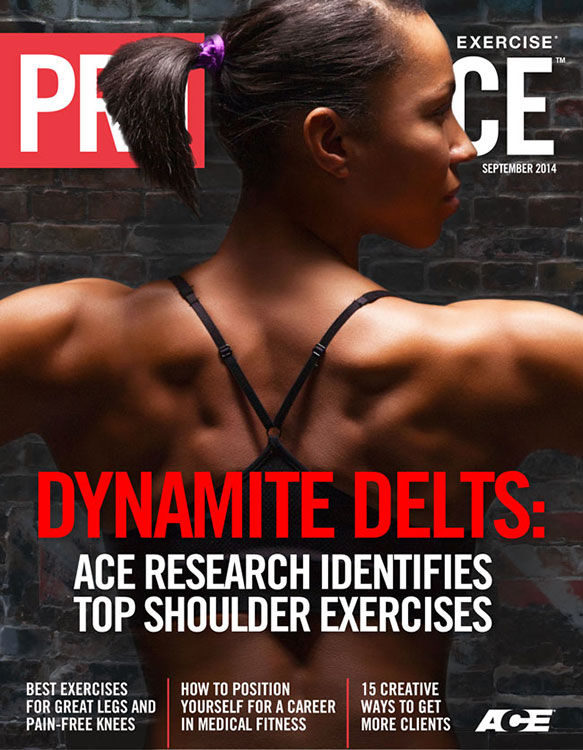








 Stand with feet hip-width apart, feet facing forward and legs straight. Extend the arms in front of the body and bend forward at the waist as far as possible without bending your knees. To minimize stress to the lower back, keep the spine straight when flexing forward. Perform two to three sets of eight to 10 repetitions, two to three times per week. Once your client is proficient at this exercise, it can be progressed by having the client stand on one leg with the arm of the opposite side raised forward (as shown in the picture). To progress even further, a small hand weight can be added to the forward arm and the range of motion can be increased with the goal of getting the trunk perpendicular to the ground.
Stand with feet hip-width apart, feet facing forward and legs straight. Extend the arms in front of the body and bend forward at the waist as far as possible without bending your knees. To minimize stress to the lower back, keep the spine straight when flexing forward. Perform two to three sets of eight to 10 repetitions, two to three times per week. Once your client is proficient at this exercise, it can be progressed by having the client stand on one leg with the arm of the opposite side raised forward (as shown in the picture). To progress even further, a small hand weight can be added to the forward arm and the range of motion can be increased with the goal of getting the trunk perpendicular to the ground.


